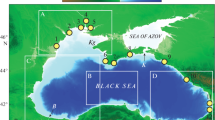Abstract
Level and current oscillations in the basin of the Sea of Azov have been studied by hydrodynamic modeling using the Princeton ocean model (POM). The hypothesis on the role of the resonance mechanism in the occurrence of extremely large amplitudes of storm surge and seiche oscillations depending on the velocity and time of motion of atmospheric fronts of the Sea of Azov has been tested. It is found that at the same wind, pressure perturbations moving over the Sea of Azov induce forced oscillations, and after the perturbations cease, free oscillations with amplitudes that are 14% higher than those obtained at constant atmospheric pressure. It is shown that the motion of the atmospheric front (whose velocity and time are selected under the assumption that waves with maximum amplitudes are generated) plays an important but not decisive role in the formation of the structure of currents and level oscillations in the Sea of Azov.
Similar content being viewed by others
References
A. S. Monin, “Classification of Nonstationary Processes in the Ocean,” Izv. Akad. Nauk SSSR, No. 7, 26–30 (1972).
V. Kh. German, “Investigation and Calculation of the Probabilistic Characteristics of Extreme Sea Levels,” Tr. Gos. Okeanograf. Inst., No. 107, 1971.
G. G. Matishov and Yu. I. Inzhebeikin, “Numerical Studies of Seiche–Like Level Oscillations in the Sea of Azov,” Okeanologiya 49 (4), 485–493 (2009).
K. M. Sirotov and T. M. Sidel’nikova, “Experience in Calculating the Wind Velocity and Wave Height in the Cold Front Zone,” Tr. Gidromettsentra SSSR, No. 263, 72–75 (1984).
F. L. Bykov and V. A. Gordin, “Objective Analysis of the Structure of Atmospheric Fronts,” Izv. Ross. Akad. Nauk, Fiz. Atmos. Okeana 48 (2), 172–188 (2014).
A. L. Chikin, “Two–Layer Mathematical Model of Wind Currents in Water Reservoirs Having Large Shallow Regions,” Mat. Model. 21 (12), 152–160 (2009).
V. A. Ivanov, L. V. Cherkesov, and T. Ya. Shu’lga, “Dynamic Processes and Their Influence on the Transformation of Passive Impurities in the Sea of Azov,” Okeanologiya 54 (4), 464–472 (2014).
V. A. Ivanov, L. V. Cherkesov, and T. Ya. Shul’ga, “Free Oscillations of the Sea of Azov Level Arising after the Cessation of a Long–Term Wind,” Mor. Gidrofiz. Zh., No. 2, 15–24 (2015).
A. F. Blumberg and G. L. Mellor, “A Description of the Three–Dimensional Coastal Ocean Circulation Model,” in Three–Dimensional Coastal Ocean Models (Amer. Geophys. Union, Washington, 1987), Vol. 4, pp. 1–16.
N. A. Labzovskii, Non–Periodic Sea Level Oscillations (Gidrometeoizdat, St. Petersburg, 1971) [in Russian].
V. S. Vasil’ev and A. I. Sukhinov, “Precision Two–Dimensional Models of Shallow Water Bodies,” Mat. Model. 15 (10), 17–34 (2003).
G. L. Mellor and T. Yamada, “Development of a Turbulence Closure Model for Geophysical Fluid Problems,” Rev. Geophys. Space Phys. 20, 851–875 (1982).
J. Smagorinsky, “General Circulation Experiments with Primitive Equations. 1. The Basic Experiment,” Monthly Weather Rev. 91 (3), 99–164 (1963).
W. Wannawong, Usa W. Humphries, P. Wongwises, and S. Vongvisessomjai, “Mathematical Modeling of Storm Surge in Three–Dimensional Primitive Equations,” Int. Comp. Math. Sci. 5 (6), 497–806 (2011).
R. Courant, K. O. Friedrichs, and H. Lewy, “On the Partial Difference Equations of Mathematical Physics,” IBM J. Res. Develop. 11 (2), 215–234 (1967).
Hydrometeorological Conditions of the Shelf Zone of the Seas of the USSR, Vol. 3: Sea of Azov(Gidrometeoizdat, Leningrad, 1986) [in Russian].
M. A. Masterskikh, Manual on Predicting Frontal Bores (Gidrometeoizdat, Leningrad, 1980) [in Russian].
Author information
Authors and Affiliations
Corresponding author
Additional information
Original Russian Text © V.A. Ivanov, T.Ya. Shul’ga.
Translated from Prikladnaya Mekhanika i Tekhnicheskaya Fizika, Vol. 59, No. 5, pp. 166–177, September–October, 2018.
Rights and permissions
About this article
Cite this article
Ivanov, V.A., Shul’ga, T.Y. Impact of Atmospheric Front Parameters on Free and Forced Oscillations of Level and Current in the Sea of Azov. J Appl Mech Tech Phy 59, 912–921 (2018). https://doi.org/10.1134/S002189441805019X
Received:
Revised:
Published:
Issue Date:
DOI: https://doi.org/10.1134/S002189441805019X




